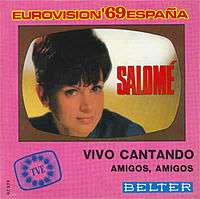Vivo cantando
 | |
| Eurovision Song Contest 1969 entry | |
| Country | |
| Artist(s) |
María Rosa Marco |
| As | |
| Language | |
| Composer(s) |
Maria José de Cerato |
| Lyricist(s) |
Aniano Alcalde |
| Conductor | |
| Finals performance | |
| Final result |
1st |
| Final points |
18 |
| Appearance chronology | |
| ◄ "La, la, la" (1968) | |
| "Gwendolyne" (1970) ► | |
"Vivo cantando" (Spanish pronunciation: [ˈbiβo kanˈtando], "I Live Singing") was one of four songs which tied for first place in the Eurovision Song Contest 1969. Performed in Spanish by Salomé for Spain, the song was joint winner with the United Kingdom's "Boom Bang-a-Bang" performed by Lulu, "De troubadour" by Lenny Kuhr representing the Netherlands, and "Un jour, un enfant" sung for France by Frida Boccara. It was Spain's second winning entry in the contest and the last to date.
The song is a very up-tempo number, sung from the perspective of a woman telling her lover about the positive changes he has had on her, specifically that she now lives her life singing. Two memorable aspects of the performance were Salomé's costume – a Pertegaz pantsuit covered in long strands of porcelain resembling beads – and the fact that the singer chose to dance on the spot during certain parts of the song. Dancing was against Eurovision Song Contest regulations at the time; Salomé was not penalized, however, as the performers from Ireland and the United Kingdom had done the same that year as well.
Salomé recorded the song in six languages; Spanish (Castellano), Catalan (as "Canto i vull viure"), Basque ("Kantari bizi naiz"), English ("The Feeling of Love"), French ("Alors je chante") and Italian ("Vivo cantando").
It was succeeded as Spanish representative at the 1970 Contest by Julio Iglesias with "Gwendolyne".
Sources and external links
- Official Eurovision Song Contest site, history by year, 1969.
- Detailed info and lyrics, The Diggiloo Thrush, "Vivo cantando".
| Preceded by "La, la, la" by Massiel |
Eurovision Song Contest winners co-winner with "De troubadour" by Lenny Kuhr, "Un jour, un enfant" by Frida Boccara and "Boom Bang-a-Bang" by Lulu 1969 |
Succeeded by "All Kinds of Everything" by Dana Rosemary Scallon |